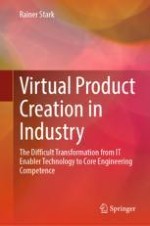2022 | OriginalPaper | Buchkapitel
21. Future Virtual Product Creation Solutions with New Engineering Capabilities
verfasst von : Rainer Stark
Erschienen in: Virtual Product Creation in Industry
Verlag: Springer Berlin Heidelberg
Aktivieren Sie unsere intelligente Suche, um passende Fachinhalte oder Patente zu finden.
Wählen Sie Textabschnitte aus um mit Künstlicher Intelligenz passenden Patente zu finden. powered by
Markieren Sie Textabschnitte, um KI-gestützt weitere passende Inhalte zu finden. powered by
